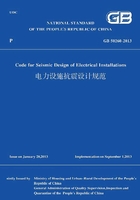
6.2 Design Method
6.2.1 The seismic design of electrical facilities should adopt the following methods:
1 The static method may be used for rigid electrical facilities with a fundamental frequency higher than 33Hz;
2 The base shear method may be used for electrical facilities which are mainly subjected to shear deformation or equivalent to a single-mass-system;
3 The mode analysis response spectrum method should be used for electrical facilities except those stated in the above provisions.
4 For electrical facilities which are especially irregular or have special requirements,the time history analysis method may be used for supplementary seismic design.
6.2.2 When the static method is used for seismic design,the earthquake action-induced bending moment or shear force may be respectively calculated with the following formulae:
1 The bending moment induced by earthquake action may be calculated with the following formula:

Where,M——bending moment induced by earthquake action,kN·m;
ao——design acceleration of ground motion;
Geq——representative value of equivalent total gravity load of structure,kN;
H0——height of gravity center of electrical facility system,m;
h——height of calculated section from the bottom,m;
g——gravitational acceleration.
2 The shear force induced by earthquake action may be calculated with the following formula:

Where,V——shear force produced by earthquake action,kN.
6.2.3 When base shear method or mode analysis response spectrum method is adopted for seismic design,it shall comply with the relevant provisions in Chapter 5 of this Code.
6.2.4 When dynamic time history analysis method is adopted for seismic design,the input ground motion time history may be the actual strong ground motion records or artificial ground motion time history.The input ground motion time histories shall be no less than three and shall at least include one artificial ground motion time history.The total duration of these time histories shall not be shorter than 30s,and the duration of strong ground motion shall not be shorter than 6s.The calculation result should be the greater between the envelope of calculation result obtained through the time history analysis method and the result obtained through the mode analysis response spectrum method.
6.2.5 When it is necessary to perform time history analysis for vertical earthquake action,the maximum vertical acceleration av of ground motion may be taken as 65% of the maximum horizontal acceleration as.
6.2.6 If the electrical equipment is installed on supporting structure,the dynamic amplification effect of supporting structure shall be fully considered.When seismic design only considers the electrical equipment,the input acceleration of ground motion shall be multiplied by the dynamic amplification factor of the supporting structure and comply with the following requirements:
1 Where the supporting structure parameters are known,the supporting structure and the electrical equipment shall be regarded as a whole for seismic design.
2 Where the supporting structure parameters are not available,for electrical equipment which is intended to be installed outdoors,on the ground floor indoors,in underground caves,on the bottom floor of underground substation or on lower supports,the dynamic amplification factor of their supports should not be less than 1.2.Also,design of these supports shall ensure that the dynamic amplification factor is not larger than the specified value.
3 For electrical equipment and devices installed on the second and third floors indoors,the dynamic amplification factor of buildings shall be taken as 2.0.For electrical equipment and devices installed on higher floors,special study shall be conducted.
4 For components mounted on transformers and reactors,the dynamic amplification factor shall be taken as 2.0.
6.2.7 The seismic design of electrical facilities shall combine the earthquake action with loads due to the total gravity of the system(including the weight of terminal plates,fittings and conductors),internal pressure,terminal force,and 0.25 times the design wind load.The combination of earthquake action and short-circuit electrodynamic force may be omitted.